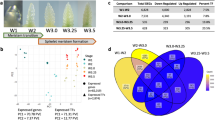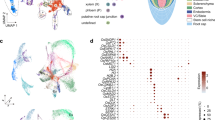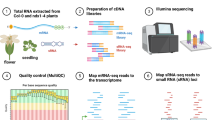Abstract
A comprehensive understanding of inflorescence development is crucial for crop genetic improvement, as inflorescence meristems give rise to reproductive organs and determine grain yield. However, dissecting inflorescence development at the cellular level has been challenging owing to a lack of specific marker genes to distinguish among cell types, particularly in different types of meristems that are vital for organ formation. In this study, we used spatial enhanced resolution omics-sequencing (Stereo-seq) to construct a precise spatial transcriptome map of the developing maize ear primordium, identifying 12 cell types, including 4 newly defined cell types found mainly in the inflorescence meristem. By extracting the meristem components for detailed clustering, we identified three subtypes of meristem and validated two MADS-box genes that were specifically expressed at the apex of determinate meristems and involved in stem cell determinacy. Furthermore, by integrating single-cell RNA transcriptomes, we identified a series of spatially specific networks and hub genes that may provide new insights into the formation of different tissues. In summary, this study provides a valuable resource for research on cereal inflorescence development, offering new clues for yield improvement.
This is a preview of subscription content, access via your institution
Access options
Access Nature and 54 other Nature Portfolio journals
Get Nature+, our best-value online-access subscription
$29.99 / 30 days
cancel any time
Subscribe to this journal
Receive 12 digital issues and online access to articles
$119.00 per year
only $9.92 per issue
Buy this article
- Purchase on Springer Link
- Instant access to full article PDF
Prices may be subject to local taxes which are calculated during checkout




Similar content being viewed by others
Data availability
The scRNA-seq and Stereo-seq data from this study can be found in CNGBdb (https://db.cngb.org/) and under project accession code CNP0004249 (https://db.cngb.org/search/project/CNP0004249/). Additional data, including the processed H5ad data, the original gene expression matrix and expression patterns of marker genes across all sections can be accessed at the STOmicsDB database90, https://db.cngb.org/stomics/mdesta/. Source data are provided with this paper.
Code availability
The code for counting and annotating mapped reads is available via GitHub at https://github.com/BGIResearch/handleBam.
References
Tanaka, W., Pautler, M., Jackson, D. & Hirano, H. Y. Grass meristems II: inflorescence architecture, flower development and meristem fate. Plant Cell Physiol. 54, 313–324 (2013).
Benlloch, R., Berbel, A., Serrano-Mislata, A. & Madueño, F. Floral initiation and inflorescence architecture: a comparative view. Ann. Bot. 100, 659–676 (2007).
Irish, E. Class II tassel seed mutations provide evidence for multiple types of inflorescence meristems in maize (Poaceae). Am. J. Bot. 84, 1502 (1997).
Jackson, D., Veit, B. & Hake, S. Expression of maize KNOTTED1 related homeobox genes in the shoot apical meristem predicts patterns of morphogenesis in the vegetative shoot. Development 120, 405–413 (1994).
Gallavotti, A. et al. The role of barren stalk1 in the architecture of maize. Nature 432, 630–635 (2004).
Vollbrecht, E., Springer, P. S., Goh, L., Buckler, E. S. T. & Martienssen, R. Architecture of floral branch systems in maize and related grasses. Nature 436, 1119–1126 (2005).
Satoh-Nagasawa, N., Nagasawa, N., Malcomber, S., Sakai, H. & Jackson, D. A trehalose metabolic enzyme controls inflorescence architecture in maize. Nature 441, 227–230 (2006).
Chuck, G., Muszynski, M., Kellogg, E., Hake, S. & Schmidt, R. J. The control of spikelet meristem identity by the branched silkless1 gene in maize. Science 298, 1238–1241 (2002).
Ning, Q. et al. An ethylene biosynthesis enzyme controls quantitative variation in maize ear length and kernel yield. Nat. Commun. 12, 5832 (2021).
Luo, Y. et al. Genetic variation in YIGE1 contributes to ear length and grain yield in maize. N. Phytol. 234, 513–526 (2022).
Lloyd, J. & Meinke, D. A comprehensive dataset of genes with a loss-of-function mutant phenotype in Arabidopsis. Plant Physiol. 158, 1115–1129 (2012).
Goldman, S. L. et al. The impact of heterogeneity on single-cell sequencing. Front. Genet. 10, 8 (2019).
Zhang, T. Q., Chen, Y., Liu, Y., Lin, W. H. & Wang, J. W. Single-cell transcriptome atlas and chromatin accessibility landscape reveal differentiation trajectories in the rice root. Nat. Commun. 12, 2053 (2021).
Zhang, T. Q., Chen, Y. & Wang, J. W. A single-cell analysis of the Arabidopsis vegetative shoot apex. Dev. Cell 56, 1056–1074.e8 (2021).
Satterlee, J. W., Strable, J. & Scanlon, M. J. Plant stem-cell organization and differentiation at single-cell resolution. Proc. Natl Acad. Sci. USA 117, 33689–33699 (2020).
Xu, X. et al. Single-cell RNA sequencing of developing maize ears facilitates functional analysis and trait candidate gene discovery. Dev. Cell 56, 557–568.e6 (2021).
Ortiz-Ramírez, C. et al. Ground tissue circuitry regulates organ complexity in maize and Setaria. Science 374, 1247–1252 (2021).
Chen, A. et al. Spatiotemporal transcriptomic atlas of mouse organogenesis using DNA nanoball-patterned arrays. Cell 185, 1777–1792.e21 (2022).
Wei, X. et al. Single-cell Stereo-seq reveals induced progenitor cells involved in axolotl brain regeneration. Science 377, eabp9444 (2022).
Liu, C. et al. Spatiotemporal mapping of gene expression landscapes and developmental trajectories during zebrafish embryogenesis. Dev. Cell 57, 1284–1298.e5 (2022).
Xia, K. et al. The single-cell stereo-seq reveals region-specific cell subtypes and transcriptome profiling in Arabidopsis leaves. Dev. Cell 57, 1299–1310.e4 (2022).
Liu, Y. et al. Spatial transcriptome analysis on peanut tissues shed light on cell heterogeneity of the peg. Plant Biotechnol. J. 20, 1648–1650 (2022).
Song, X. et al. Spatial transcriptomics reveals light-induced chlorenchyma cells involved in promoting shoot regeneration in tomato callus. Proc. Natl Acad. Sci. USA 120, e2310163120 (2023).
Liu, Z. et al. Integrated single-nucleus and spatial transcriptomics captures transitional states in soybean nodule maturation. Nat. Plants 9, 515–524 (2023).
Vollbrecht, E. & Schmidt, R.J. in Handbook of Maize: Its Biology (eds Bennetzen, J. L. & Hake, S. C.) 13–40 (Springer New York, 2009).
Ambrose, B. A. et al. Molecular and genetic analyses of the silky1 gene reveal conservation in floral organ specification between eudicots and monocots. Mol. Cell 5, 569–579 (2000).
Bommert, P. et al. thick tassel dwarf1 encodes a putative maize ortholog of the Arabidopsis CLAVATA1 leucine-rich repeat receptor-like kinase. Development 132, 1235–1245 (2005).
Bortiri, E. et al. ramosa2 encodes a LATERAL ORGAN BOUNDARY domain protein that determines the fate of stem cells in branch meristems of maize. Plant Cell 18, 574–585 (2006).
Chen, Z. et al. Structural variation at the maize WUSCHEL1 locus alters stem cell organization in inflorescences. Nat. Commun. 12, 2378 (2021).
Chuck, G., Meeley, R. & Hake, S. Floral meristem initiation and meristem cell fate are regulated by the maize AP2 genes ids1 and sid1. Development 135, 3013–3019 (2008).
Chuck, G., Meeley, R. B. & Hake, S. The control of maize spikelet meristem fate by the APETALA2-like gene indeterminate spikelet1. Genes Dev. 12, 1145–1154 (1998).
Chuck, G. S., Brown, P. J., Meeley, R. & Hake, S. Maize SBP-box transcription factors unbranched2 and unbranched3 affect yield traits by regulating the rate of lateral primordia initiation. Proc. Natl Acad. Sci. USA 111, 18775–18780 (2014).
Gallavotti, A. et al. The control of axillary meristem fate in the maize ramosa pathway. Development 137, 2849–2856 (2010).
Galli, M. et al. Auxin signaling modules regulate maize inflorescence architecture. Proc. Natl Acad. Sci. USA 112, 13372–13377 (2015).
Kerstetter, R. A., Laudencia-Chingcuanco, D., Smith, L. G. & Hake, S. Loss-of-function mutations in the maize homeobox gene, knotted1, are defective in shoot meristem maintenance. Development 124, 3045–3054 (1997).
Liu, R. et al. Fine mapping and candidate gene prediction of a pleiotropic quantitative trait locus for yield-related trait in Zea mays. PLoS ONE 7, e49836 (2012).
Pautler, M. et al. FASCIATED EAR4 encodes a bZIP transcription factor that regulates shoot meristem size in maize. Plant Cell 27, 104–120 (2015).
Skirpan, A., Wu, X. & McSteen, P. Genetic and physical interaction suggest that BARREN STALK 1 is a target of BARREN INFLORESCENCE2 in maize inflorescence development. Plant J. 55, 787–797 (2008).
Strable, J. & Vollbrecht, E. Maize YABBY genes drooping leaf1 and drooping leaf2 regulate floret development and floral meristem determinacy. Development 146, dev171181 (2019).
Strable, J. et al. Maize YABBY genes drooping leaf1 and drooping leaf2 regulate plant architecture. Plant Cell 29, 1622–1641 (2017).
Xu, G. et al. Complex genetic architecture underlies maize tassel domestication. N. Phytol. 214, 852–864 (2017).
Zhang, D. et al. GRF-interacting factor1 regulates shoot architecture and meristem determinacy in maize. Plant Cell 30, 360–374 (2018).
Whipple, C. J. et al. A conserved mechanism of bract suppression in the grass family. Plant Cell 22, 565–578 (2010).
Chuck, G., Whipple, C., Jackson, D. & Hake, S. The maize SBP-box transcription factor encoded by tasselsheath4 regulates bract development and the establishment of meristem boundaries. Development 137, 1243–1250 (2010).
Du, Y. et al. UNBRANCHED3 expression and inflorescence development is mediated by UNBRANCHED2 and the distal enhancer, KRN4, in maize. PLoS Genet. 16, e1008764 (2020).
Jia, H. et al. A serine/threonine protein kinase encoding gene KERNEL NUMBER PER ROW6 regulates maize grain yield. Nat. Commun. 11, 988 (2020).
Xiao, Y. et al. Boundary domain genes were recruited to suppress bract growth and promote branching in maize. Sci. Adv. 8, eabm6835 (2022).
Chuck, G. & Bortiri, E. The unique relationship between tsh4 and ra2 in patterning floral phytomers. Plant Signal. Behav. 5, 979–981 (2010).
Bartlett, M. E. et al. The maize PI/GLO ortholog Zmm16/sterile tassel silky ear1 interacts with the zygomorphy and sex determination pathways in flower development. Plant Cell 27, 3081–3098 (2015).
Satija, R., Farrell, J. A., Gennert, D., Schier, A. F. & Regev, A. Spatial reconstruction of single-cell gene expression data. Nat. Biotechnol. 33, 495–502 (2015).
Kim, D. E. et al. The impact of fasciation on maize inflorescence architecture. J. Plant Biol. 65, 87–98 (2022).
Du, Y., Wu, B., Xing, Y. & Zhang, Z. Conservation and divergence: regulatory networks underlying reproductive branching in rice and maize. J. Adv. Res. 41, 179–190 (2022).
Qiu, X. et al. Reversed graph embedding resolves complex single-cell trajectories. Nat. Methods 14, 979–982 (2017).
Korsunsky, I. et al. Fast, sensitive and accurate integration of single-cell data with Harmony. Nat. Methods 16, 1289–1296 (2019).
Sun, D., Liu, Z., Li, T., Wu, Q. & Wang, C. STRIDE: accurately decomposing and integrating spatial transcriptomics using single-cell RNA sequencing. Nucleic Acids Res. 50, e42 (2022).
Langfelder, P. & Horvath, S. WGCNA: an R package for weighted correlation network analysis. BMC Bioinform. 9, 559 (2008).
Douglas, C. J. Phenylpropanoid metabolism and lignin biosynthesis: from weeds to trees. Trends Plant Sci. 1, 171–178 (1996).
Saha, P. et al. Phenylpropanoid biosynthesis gene expression precedes lignin accumulation during shoot development in lowland and upland switchgrass genotypes. Front. Plant Sci. 12, 640930 (2021).
Suh, M. C. et al. Cuticular lipid composition, surface structure, and gene expression in Arabidopsis stem epidermis. Plant Physiol. 139, 1649–1665 (2005).
Shannon, P. et al. Cytoscape: a software environment for integrated models of biomolecular interaction networks. Genome Res. 13, 2498–2504 (2003).
Luo, B., Xue, X. Y., Hu, W. L., Wang, L. J. & Chen, X. Y. An ABC transporter gene of Arabidopsis thaliana, AtWBC11, is involved in cuticle development and prevention of organ fusion. Plant Cell Physiol. 48, 1790–1802 (2007).
Panikashvili, D. et al. The Arabidopsis DESPERADO/AtWBC11 transporter is required for cutin and wax secretion. Plant Physiol. 145, 1345–1360 (2007).
Javelle, M. et al. Overexpression of the epidermis-specific homeodomain-leucine zipper IV transcription factor OUTER CELL LAYER1 in maize identifies target genes involved in lipid metabolism and cuticle biosynthesis. Plant Physiol. 154, 273–286 (2010).
Todd, J., Post-Beittenmiller, D. & Jaworski, J. G. KCS1 encodes a fatty acid elongase 3-ketoacyl-CoA synthase affecting wax biosynthesis in Arabidopsis thaliana. Plant J. 17, 119–130 (1999).
Sturaro, M. et al. Cloning and characterization of GLOSSY1, a maize gene involved in cuticle membrane and wax production. Plant Physiol. 138, 478–489 (2005).
Wang, J. et al. Lignin engineering through laccase modification: a promising field for energy plant improvement. Biotechnol. Biofuels 8, 145 (2015).
Zhao, Q. et al. Laccase is necessary and nonredundant with peroxidase for lignin polymerization during vascular development in Arabidopsis. Plant Cell 25, 3976–3987 (2013).
Nuccio, M. L. et al. Expression of trehalose-6-phosphate phosphatase in maize ears improves yield in well-watered and drought conditions. Nat. Biotechnol. 33, 862–869 (2015).
Kataya, A. R. A. et al. Multi-targeted trehalose-6-phosphate phosphatase I harbors a novel peroxisomal targeting signal 1 and is essential for flowering and development. Planta 251, 98 (2020).
Li, Z. et al. The OsNAC23–Tre6P–SnRK1a feed-forward loop regulates sugar homeostasis and grain yield in rice. Mol. Plant 15, 706–722 (2022).
Yang, X. et al. Characterization of a global germplasm collection and its potential utilization for analysis of complex quantitative traits in maize. Mol. Breed. 28, 511–526 (2011).
Yang, N. et al. Genome wide association studies using a new nonparametric model reveal the genetic architecture of 17 agronomic traits in an enlarged maize association panel. PLoS Genet. 10, e1004573 (2014).
Gui, S. et al. A pan-Zea genome map for enhancing maize improvement. Genome Biol. 23, 178 (2022).
Li, M., Zhong, W., Yang, F. & Zhang, Z. Genetic and molecular mechanisms of quantitative trait loci controlling maize inflorescence architecture. Plant Cell Physiol. 59, 448–457 (2018).
Liu, L. et al. Enhancing grain-yield-related traits by CRISPR–Cas9 promoter editing of maize CLE genes. Nat. Plants 7, 287–294 (2021).
Wu, Q., Xu, F. & Jackson, D. All together now, a magical mystery tour of the maize shoot meristem. Curr. Opin. Plant Biol. 45, 26–35 (2018).
Claeys, H. et al. Control of meristem determinacy by trehalose 6-phosphate phosphatases is uncoupled from enzymatic activity. Nat. Plants 5, 352–357 (2019).
Hufford, M. B. et al. De novo assembly, annotation, and comparative analysis of 26 diverse maize genomes. Science 373, 655–662 (2021).
Dobin, A. et al. STAR: ultrafast universal RNA-seq aligner. Bioinformatics 29, 15–21 (2013).
Butler, A., Hoffman, P., Smibert, P., Papalexi, E. & Satija, R. Integrating single-cell transcriptomic data across different conditions, technologies, and species. Nat. Biotechnol. 36, 411–420 (2018).
Stuart, T. et al. Comprehensive integration of single-cell data. Cell 177, 1888–1902.e21 (2019).
Crow, M., Paul, A., Ballouz, S., Huang, Z. J. & Gillis, J. Characterizing the replicability of cell types defined by single cell RNA-sequencing data using MetaNeighbor. Nat. Commun. 9, 884 (2018).
La Manno, G. et al. RNA velocity of single cells. Nature 560, 494–498 (2018).
Wolf, F. A., Angerer, P. & Theis, F. J. SCANPY: large-scale single-cell gene expression data analysis. Genome Biol. 19, 15 (2018).
Bergen, V., Lange, M., Peidli, S., Wolf, F. A. & Theis, F. J. Generalizing RNA velocity to transient cell states through dynamical modeling. Nat. Biotechnol. 38, 1408–1414 (2020).
Tu, X. et al. Reconstructing the maize leaf regulatory network using ChIP-seq data of 104 transcription factors. Nat. Commun. 11, 5089 (2020).
Yoo, S. D., Cho, Y. H. & Sheen, J. Arabidopsis mesophyll protoplasts: a versatile cell system for transient gene expression analysis. Nat. Protoc. 2, 1565–1572 (2007).
McGinnis, C. S., Murrow, L. M. & Gartner, Z. J. DoubletFinder: doublet detection in single-cell RNA sequencing data using artificial nearest neighbors. Cell Syst. 8, 329–337.e4 (2019).
Speed, D., Hemani, G., Johnson, M. R. & Balding, D. J. Improved heritability estimation from genome-wide SNPs. Am. J. Hum. Genet. 91, 1011–1021 (2012).
Xu, Z. et al. STOmicsDB: a comprehensive database for spatial transcriptomics data sharing, analysis and visualization. Nucleic Acids Res. 5, D1053–D1061 (2023).
Acknowledgements
This research was supported by funding from the National Key R&D Program of China (grant no. 2023ZD04073) to N.Y. and H.L., the National Natural Science Foundation of China (grant nos 32222062 and 32321005) and the National Key Laboratory of Crop Genetic Improvement Self-Research Program (grant no. ZW22B0102) to N.Y., the Outstanding Youth Team Cultivation Project of Center Universities (grant no. 2662023PY007) to L. Liu, the Shenzhen Science and Technology Program (grant no. KQTD20230301092839007) to H.L., the China Postdoctoral Science Foundation (grant no. 2023M731239) to Y. Luo, the National Key Research and Development Program of China (grant nos 2022YFD1201500 and 2020YFE0202300) to Jianbing Yan, and NSF-IOS grant no. 1934388 to D.J. Computation resources were provided by the high-throughput computing platform of the National Key Laboratory of Crop Genetic Improvement at Huazhong Agricultural University and supported by H.L. The construction of the spatial transcriptome visualization website is supported by the Guangdong Genomics Data Center (grant no. 2021B1212100001).
Author information
Authors and Affiliations
Contributions
N.Y., L. Liu and H.L. conceived and supervised this study. Y.W., Y. Luo, X.G., Jiali Yan, W.S., L.C., Q.D., L. Li and L.Z. performed the library preparation and sequencing. Y.W., X.G., W.S., M.B. and W.W. performed the bioinformatics analysis. X.W., T.Y. and J.C. established the online database. Y. Li finished the transgenic and in situ experiments. Y.W., Y. Luo, X.G., Jiali Yan, Y. Li, D.J., Z.Z., X.X., Jianbing Yan, N.Y., L. Liu and H.L. discussed the data and prepared the manuscript. All authors read and approved the manuscript.
Corresponding authors
Ethics declarations
Competing interests
The authors declare no competing interests.
Peer review
Peer review information
Nature Plants thanks Clinton Whipple, Jixian Zhai and the other, anonymous, reviewer(s) for their contribution to the peer review of this work.
Additional information
Publisher’s note Springer Nature remains neutral with regard to jurisdictional claims in published maps and institutional affiliations.
Supplementary information
Supplementary Information
Supplementary Figs. 1–30.
Supplementary Tables
Supplementary Tables 1–10.
Supplementary Data 1
mRNA in situ hybridization of marker genes identified in Stereo-seq. Left, mRNA in situ hybridization results. Right, Stereo-seq expression pattern; the arrow indicates the gene expression region that matches the in situ results. Scale bar, 0.1 mm.
Supplementary Data 2
Statistical data for Supplementary Figs. 2, 3, 6, 9, 10, 17, 24–26, 29 and 30.
Source data
Source Data Figs. 1–4
Statistical source data.
Rights and permissions
Springer Nature or its licensor (e.g. a society or other partner) holds exclusive rights to this article under a publishing agreement with the author(s) or other rightsholder(s); author self-archiving of the accepted manuscript version of this article is solely governed by the terms of such publishing agreement and applicable law.
About this article
Cite this article
Wang, Y., Luo, Y., Guo, X. et al. A spatial transcriptome map of the developing maize ear. Nat. Plants 10, 815–827 (2024). https://doi.org/10.1038/s41477-024-01683-2
Received:
Accepted:
Published:
Issue Date:
DOI: https://doi.org/10.1038/s41477-024-01683-2



